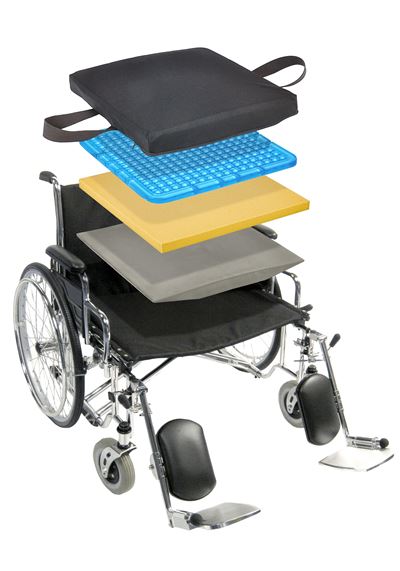-
Home
-
Choosing a Wheelchair Cushion: Which Type is Right for You?
Choosing a Wheelchair Cushion: Which Type is Right for You?
March 23, 2023

For those in wheelchairs, comfort is essential. Yet the abundance of cushioning options can be overwhelming. Foam cushions, gel cushions, and air cushions are among the most effective choices—but which one to choose? We take a comprehensive look at these 3 types of wheelchair padding to help you choose a cushion that’s right for you.
Foam Wheelchair Cushions
Foam cushions come in a variety of densities, so finding the one that is right for you isn’t too difficult. As far as thickness goes, it really depends on the user's weight and size; heavier people may need thicker foam in order to get enough support from the cushion. Foam is great at providing even pressure distribution and helping keep your spine in proper alignment during long sitting periods, but it does tend to flatten out over time and lose its shape. To make sure your foam cushion stays comfortable for as long as possible, rotate it every few months or so when you're not using it.
AliMed® Bariatric Tri-Foam Cushions provide advanced pressure relief, helping to prevent pressure ulcers without bottoming out for heavier users weighing up to 1,000 pounds.
AliMed® Independent Cell Cushions conform to the shape of the body, minimizing painful friction on the skin while providing outstanding support and evenly distributing pressure throughout the entire seating surface.
Gel Wheelchair Cushions
Gel cushions are made up of two layers—a firm base layer and a softer gel layer—making them ideal for those who are looking for comfort and support combined. These cushions tend to conform more easily to each individual’s body shape than foam ones do—which can help relieve pressure points while still providing adequate support—and they are more long term than traditional foam cushions because their shape doesn't change as much over time. However, they can be quite heavy and may not be suitable for those with limited upper body strength or poor posture control.
AliMed® T-Gel™ Checkerboard Wheelchair Cushions are ideal for scenarios where minimal cushioning is necessary. The low-profile design is suitable for any seat, and soft rubber elastomer gel replicates skin tissue, allowing it to move with the skin to reduce friction and shear forces while minimizing the occurrence of pressure injuries.
AliMed® Super-Economy Gel Cushions combine a gel bladder for pressure relief with a foam cushioning outer layer for maximum protection.
Air Wheelchair Cushions
Air cushions are popular because they provide excellent pressure relief due to their adjustable inflation feature; this allows users to customize their cushion depending on their needs and preferences. They also have an advantage over other types of wheelchair cushioning in that they tend to stay cooler than foam or gel models since air circulates freely through them while they're being used. However, they're not always as supportive as other types of wheelchair cushions since some may not conform closely enough to each user's body shape. This can lead to positioning problems if you don't use them correctly or adjust them properly before sitting down in your chair for extended periods of time. Plus, because these cushions require regular inflation adjustments (usually once per month), some users may find them too much of a hassle or worry about having access to an air pump when needed.
ROHO® MOSAIC® Wheelchair Cushions with AIR FLOATATION™ technology give you a level of comfort and support that is truly tailored to your body, featuring a flexible design of interconnected air cells—each 3 inches in height—that molds around the contours of your shape for a custom feel.
ROHO® QUADTRO® SELECT® Wheelchair Cushions allow for easy adjustment to ensure the desired position and comfort level for each individual user, with low-friction, low-shear positioning that not only prevents but helps heal pressure ulcers.
Prioritizing Your Needs
Choosing the right type of wheelchair cushion can be daunting as there are many options. Ultimately though, selecting the best one comes down to personal preference; what works well for one person might not work well for another. Consider your individual needs carefully before making a decision—do you need more support or more comfort? Is weight an important consideration? Do you prefer something that requires minimal maintenance? Keeping these factors in mind will help narrow down your search and ensure you get the most out of your new wheelchair cushion.